Australia’s most deadly snakes and how you identify them
Australia is known for its beautiful lifestyle … and its deadly snakes. These are the most deadly – and how you can spot them.
Australia is known for its beautiful lifestyle … and its deadly animals.
With snake season running in the warmer months from September through to April, these are the most dangerous reptiles you need to keep an eye out for.
This is everything you need to know about snake season, including what you should do if you get bitten.
Here are 10 of the most deadly Australian snakes and how to spot them >>>
10. Red-bellied black snake (Pseudechis porphyriacus)
Where: The east coast (except Tasmania) and just into southeastern South Australia.
Identification: A medium-sized snake, with a moderate to robust build and head barely distinct from the neck. Dorsal head and body colour is uniform black, except for the snout which is often pale brown. The lowest lateral scale rows and the outer edge of the ventral scales are bright crimson, fading to duller red, orange or pink in the middle of the belly. In the north of the range the ventral colour may be greyish-pink to white. The underside of the tail is black.
Source: Australian Museum

While less venomous than many other Australian snakes, it’s more likely to be in urban areas.
Red-bellied blacks are one of the few large venomous snakes still found in the Sydney region, and at 2m can eat other snakes.
They are not particularly aggressive and will escape from humans if possible, but when threatened will flatten their bodies and hiss loudly.
No deaths have been confirmed from bites by this species.
9. Common death adder (Acanthophis antarcticus)
Where: Eastern Australia – except the far north and south – and southern South Australia and Western Australia.
Identification: The Common Death Adder is easily recognised by its triangular-shaped head, short stout body and thin tail.
Source: Australian Museum
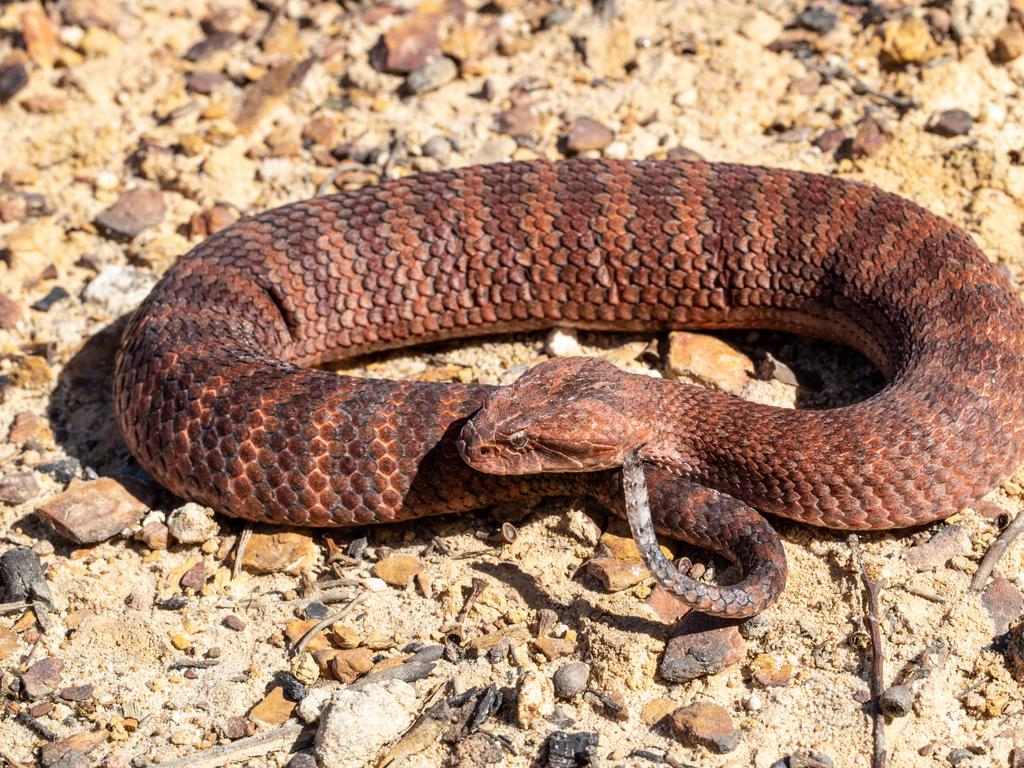
An ambush predator that hides motionless, then twitching the wormlike lure on the end of its tail to attract prey.
Unlike other snakes that flee from humans, these snakes are more likely to risk being trodden on, making them more dangerous.
About half of death adder bites proved fatal before the introduction of antivenom.
8. Small-eyed snake (Rhinoplocephalus nigrescens)
Where: Along the east coast from Victoria to Cape York.
Identification: A small to moderately-sized species. The head is slightly flattened and barely distinct from the solid body. The back, sides and top of the head and body are steely blue-black. The ventral colour ranges from cream (in the south) to bright coral pink (in the north), and is often flecked or blotched with black.
Source: Australian Museum

At about 50cm long, these snakes still pack a punch.
Though common, small-eyed snakes largely come out at night and therefore often avoid humans.
When disturbed they may thrash about aggressively, but are not usually inclined to bite.
7. Lowlands copperhead (Austrelaps superbus)
Where: In cold climates in southern Victoria, Tasmania and the islands of Bass Strait.
Identification: All species of copperheads are fairly similar in general form and colouration. They are moderately robust and muscular in build. The scales of the back and upper sides are semi-glossy and uniformly blackish to grey brown in colour, with a brownish or orange flush in some individuals of Lowland and Highland Copperheads. The lowermost rows of lateral scales are enlarged and these are usually a paler colour, particularly on the neck and forebody.
Source: Australian Museum
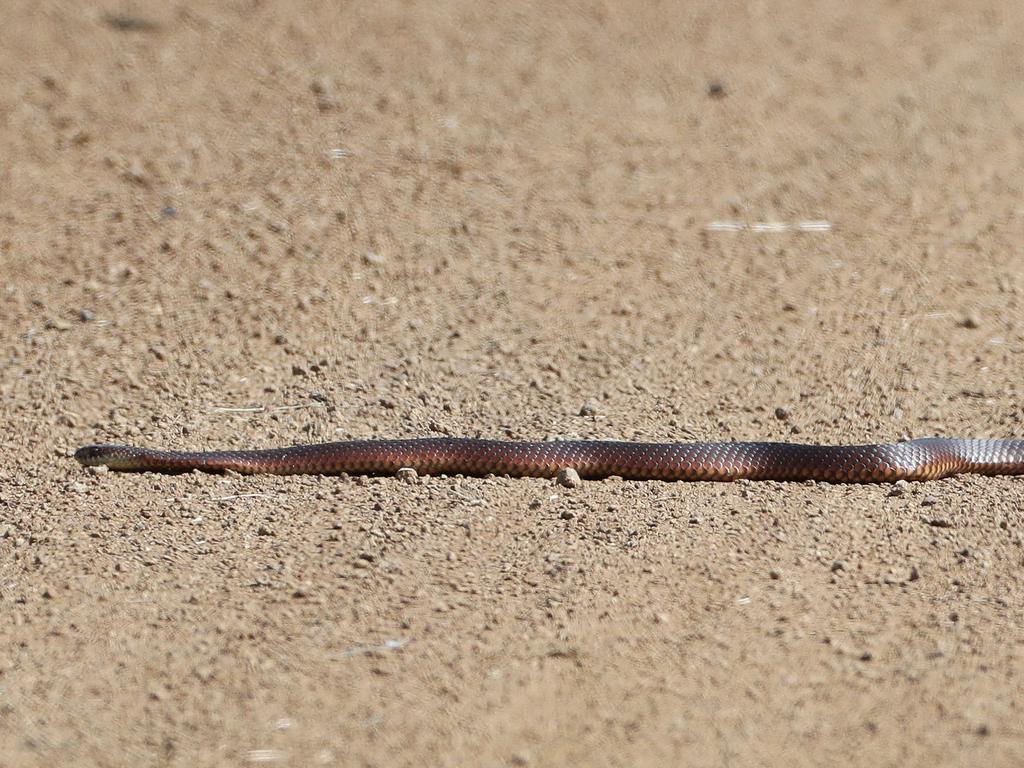
The the only venomous snake found above the snow line, active in weather usually too cold for snakes.
Copperheads are shy and avoid people, though they live in populated and agricultural areas.
When cornered they hiss loudly, flatten their body and thrash about.
6. Mulga snake (Pseudechis australis)
Where: Across most of Australia except Victoria, Tasmania and southern parts of Western Australia.
Identification: Juvenile snakes may be of average built but adults are usually quite robust, with a broad deep head and bulbous cheeks. The scales on the back, sides and tail are usually two-toned; a darker colour covers the distal portion of the scale to various degrees (from just the very tip to almost the entire scale) and may be brown, reddish brown, coppery brown or brownish black.
Source: Australian Museum
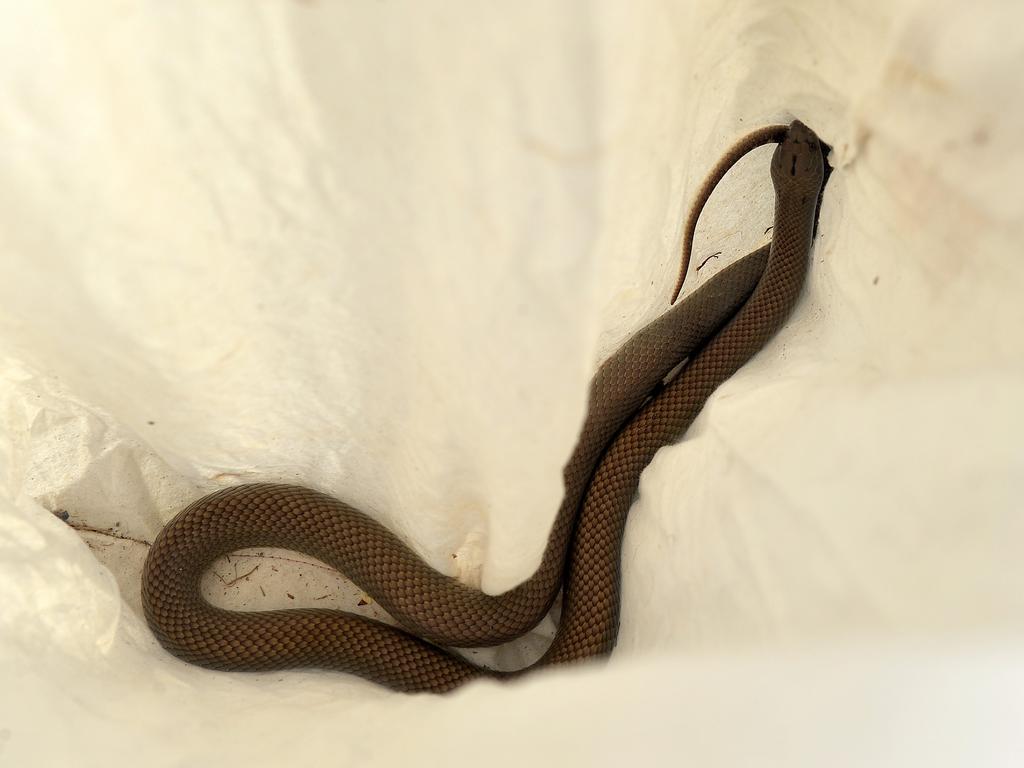
The mulga is the heaviest venomous snake in Australia and has the largest-recorded venom output of any in the world, delivering 150mg in one bite.
Southern mulgas are said to be shy; northern specimens are much more aggressive if disturbed.
Mulgas bite savagely, even hanging on and chewing as they inject massive amounts of highly toxic venom, which destroys blood cells and affects the muscles and nerves.
5. Coastal taipan (Oxyuranus scutellatus)
Where: Along the east coast from northern New South Wales to Brisbane, and northern Western Australia.
Identification: A medium to large snake, with a robust build and a deep, rectangular-shaped head distinct from the slender neck. Body colour may be yellowish, reddish brown, dark brown or almost black. The species undergoes a seasonal change in colour, with individuals becoming darker in winter and fading in summer.
Source: Australian Museum
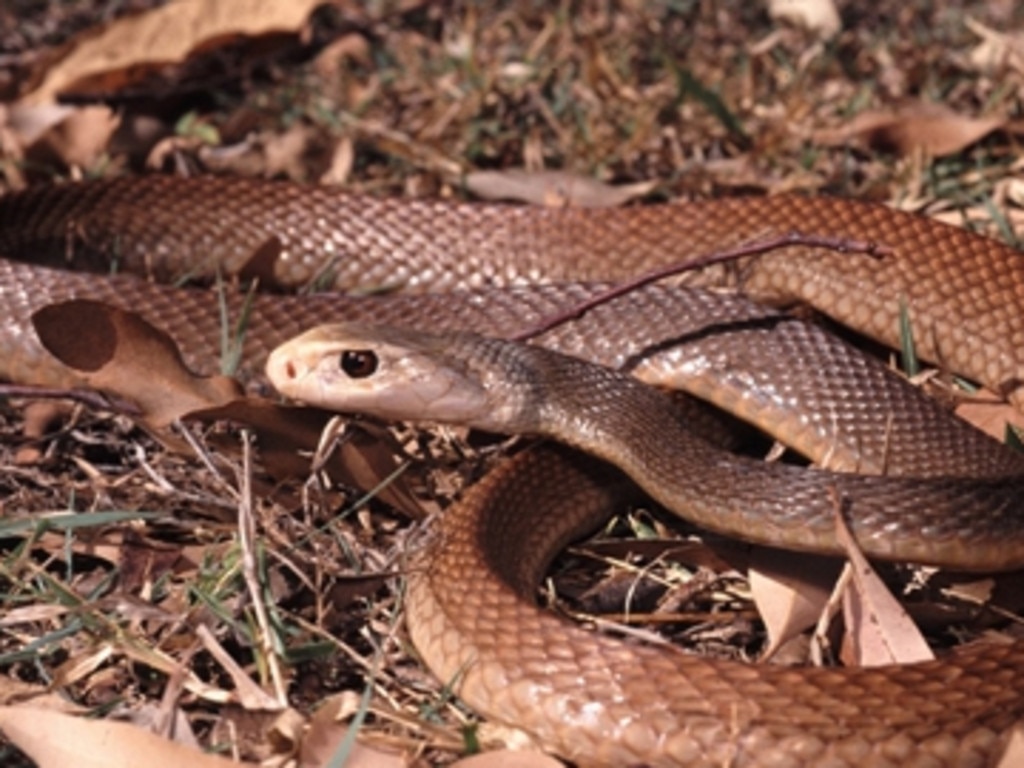
Coastal taipans have the longest fangs of any Australian snake (13mm), and have the third most toxic venom of any land snakes.
They are known to put up a strong defence when surprised or cornered.
However generally they are not confrontational and usually flee before fighting.
4. Inland taipan (Oxyuranus microlepidotus)
Where: In cracks on dry plains where the Queensland, South Australia, NSW and Northern Territory borders meet.
Identification: A medium to large snake, with a robust build and a deep, rectangular-shaped head. Dorsal colour varies from pale fawn to yellowish-brown to dark brown, with the head and neck being several to many shades darker than the body. Colour changes seasonally, with individuals becoming darker in winter and fading in summer.
Source: Australian Museum

Also known as the fierce snake or small-scaled snake, inland taipans hide in remote areas.
Despite that its highly toxic venom is considered to be the most potent of any land snake in the world.
Hunting in the confined space of the burrows of the long-haired rat, the inland taipan uses its potent venom to finish off prey quickly.
3. Mainland tiger snake (Notechis scutatus)
Where: NSW, Tasmania, Victoria and the far corner of South Australia.
Identification: The common name refers to the prominent yellow and black cross-bands typical of some populations of tiger snakes, however not all have this pattern. The most commonly seen form is dark olive brown to blackish-brown, with off-white to yellowish cross-bands that can vary in thickness.
Source: Australian Museum
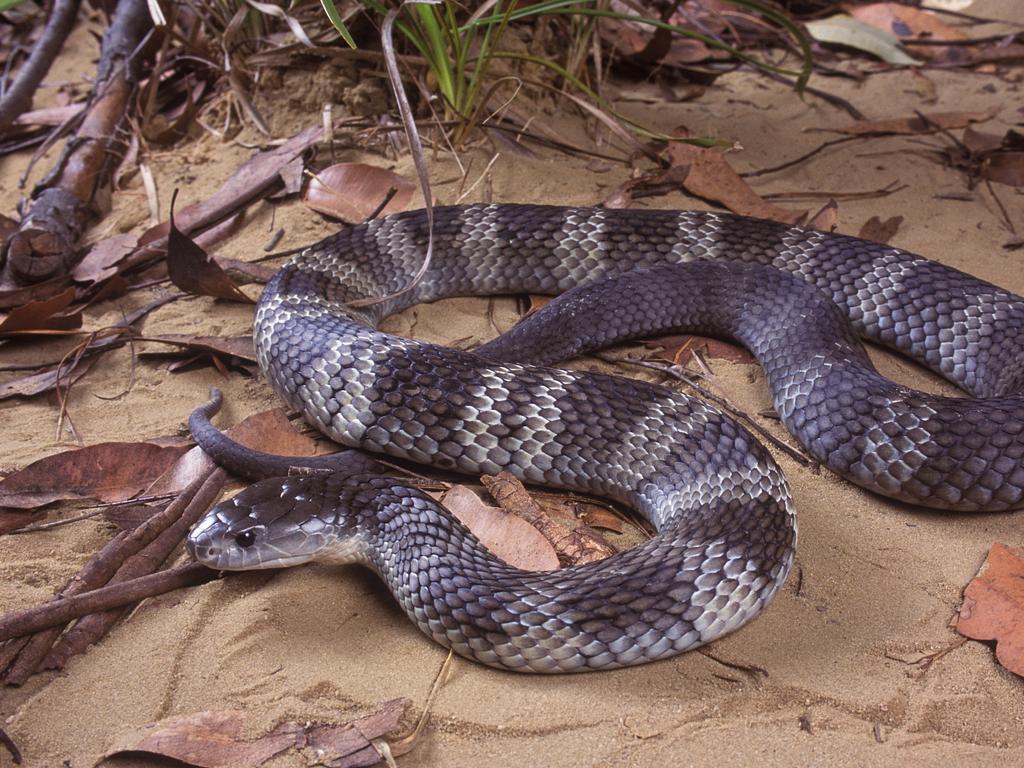
Due to the areas they live in, mainland tiger snakes are responsible for the second-highest number of bites in Australia.
They are attracted to farms and outer suburban houses, hunting mice nocturnally.
Bites are fatal if untreated, causing pain in the feet and neck, tingling, numbness and sweating, followed by breathing difficulties and paralysis.
2. Western brown snake (Pseudonaja nuchalis)
Where: Over most of mainland Australia, except for the wetter fringes of eastern Australia and southwestern Western Australia.
Identification: A long and slender snake, with a smallish head indistinct from the neck. When viewed from above the snout has a chisel-shaped appearance due in part to the enlarged straplike rostral scale. Scales are smooth and semi-glossy, often very glossy around the head and neck.
Source: Australian Museum
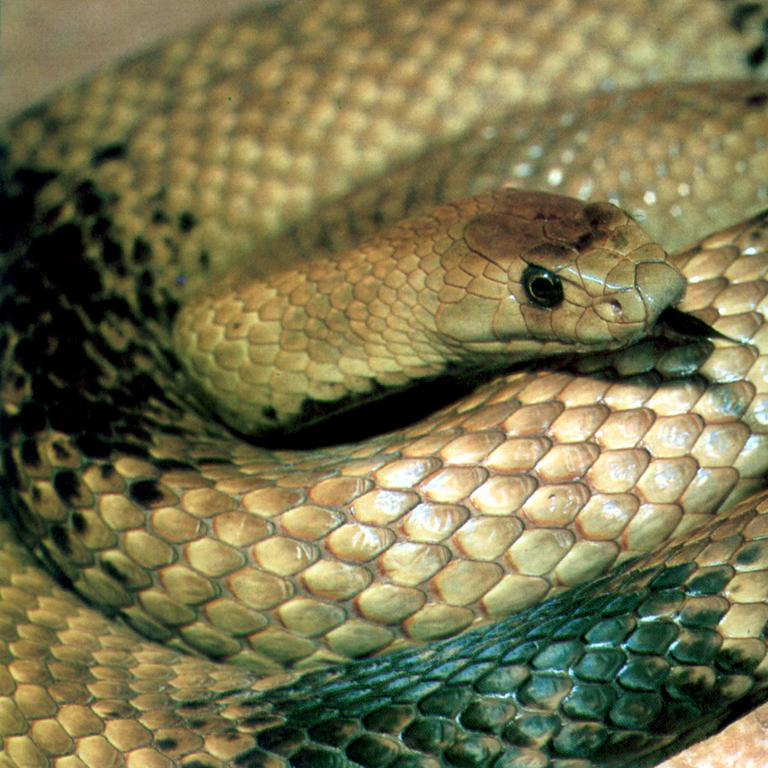
Also known as gwardar, it is thought to be less aggressive than its eastern cousin but still highly dangerous.
When disturbed they will run for cover, striking quickly if cornered, then making a quick getaway.
Though their venom is not as toxic as the eastern brown’s, they deliver three times as much. Bites are usually painless and difficult to see.
1. Eastern brown snake (Pseudonaja textilis)
Where: Mainly the eastern half of mainland Australia
Identification: A medium sized snake, with a slender to moderate build and a smallish head barely distinct from the neck. Body colour may be almost any shade of brown, ranging from near black to light tan, chestnut or burnt-orange.
Source: Australian Museum
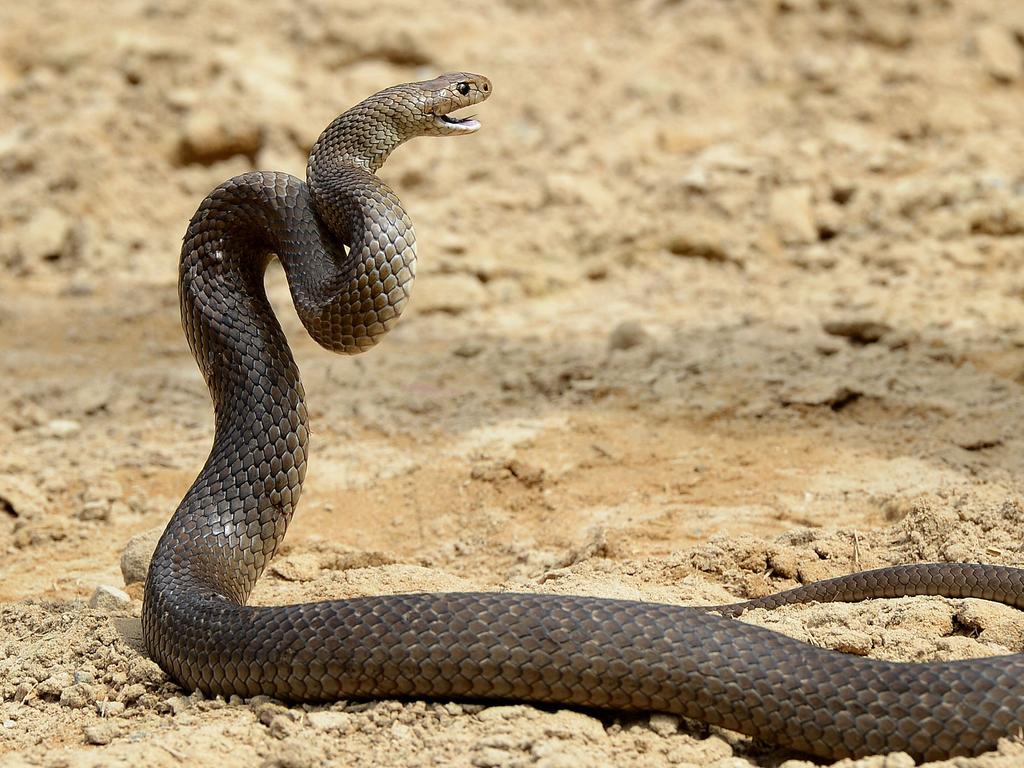
Also known as a common brown snake, these snakes are quick, aggressive and bad tempered.
Along with other browns they are responsible for more deaths every year in Australia than any other group of snakes.
Their venom is the second most toxic of any land snake in the world and they thrive in populated areas, particularly on farms.
If disturbed, it raises its body off the ground in an ‘S’ shape, with its mouth open.
â– How do you tell all kinds of snakes apart? More information here.
Additional source: Australian Geographic
Originally published as Australia’s most deadly snakes and how you identify them


